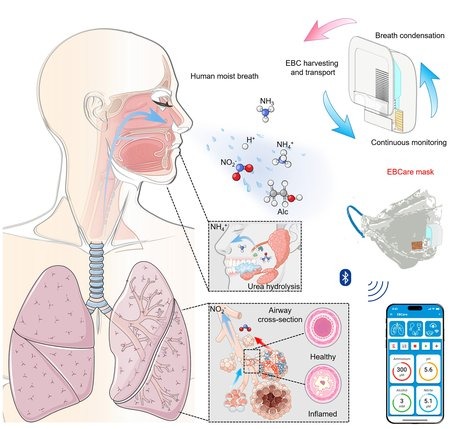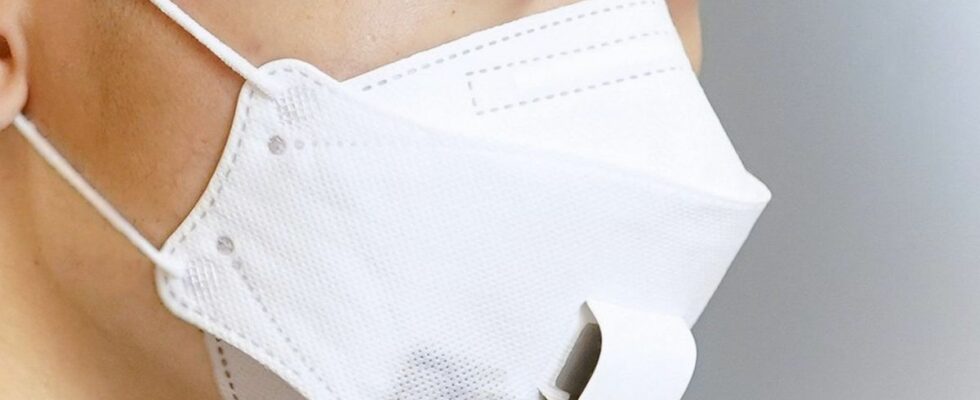Published on
updated on
Reading 3 min.
Face mask technology is taking a leap forward. A new smart mask designed to analyze the air we exhale could transform the way we monitor our health. But what makes this device so special and why should you pay attention to it?
A person’s exhaled breath—which provides information that can reveal various insights into health—has been difficult to analyze until now. Now, a new “smart mask” enables real-time, noninvasive monitoring of what people exhale. The mask, called EBCare, captures and analyzes exhaled breath condensate (EBC), and offers a promising solution for continuous EBC analysis at an affordable cost.
An incredibly innovative device
“Monitoring a patient’s breath is a common practice, for example to assess asthma and other respiratory problems. However, it requires the patient to visit a clinic for sample collection, followed by a waiting period for lab results.“We’re talking about a mask,” says Wei Gao, a professor of medical engineering at Caltech and lead researcher on a new study describing the mask in the journal Science. The researchers also noted that the widespread use of masks since the COVID-19 outbreak offers an unprecedented opportunity for personalized, real-time monitoring of our own health at home or in the office. If the analysis is reliable, it could, for example, detect certain diseases but also assess the effectiveness of ongoing treatment.

The first step is for the mask to cool the breath vapor until it turns into a liquid. To achieve this, Gao’s new mask has a passive cooling system through hydrogel evaporation and metamaterial radiation and a device frame with high thermal conductivity.Breath condensate contains soluble gases as well as non-volatile substances in the form of aerosols or droplets, such as metabolic substances, inflammatory indicators and pathogens.” explains Wenzheng Heng, lead author of the study and a graduate student at Caltech.
Once the air has been transformed into liquid, a series of capillaries (inspired by the way plants transport water), part of a class of devices called bioinspired microfluidics, immediately transport the liquid to sensors for analysis. The results of the analysis are then transmitted wirelessly to a phone, tablet or personal computer.Smart mask can be prepared at relatively low cost“, Gao explains. “It is designed to cost only about $1 in materials“.
Precision never seen before in a mask
To test the effectiveness of their device, the team conducted a series of studies focusing on patients with asthma and COPD. They monitored the patients’ breath for the presence of nitrite, a biomarker of inflammation in both conditions. The results showed that the masks accurately detected the biomarker, indicating inflammation in the patients’ airways.
In another study, the team demonstrated that the masks accurately detected blood alcohol levels, suggesting that the masks could be used for roadside checks.
They also studied how these masks could be used to assess blood urea levels as part of monitoring and managing kidney disease. At the same time, urea increases in saliva, which breaks down into ammonia gas, leading to higher ammonium levels in the breath condensate. The new study showed that smart masks could accurately detect these ammonium levels, closely reflecting blood urea levels.
For Professor Gao, “We want to extend this technology to include different markers related to various health conditions. This is a basis for creating a mask that functions as a versatile platform for monitoring general health.“.
Implications for the future of health?
The introduction of this smart mask could represent a major turning point in the way healthcare professionals and individuals manage illnesses. Not only could it reduce the spread of infections through faster detection, it could also ease the burden on healthcare systems by facilitating real-time, at-home testing.
However, challenges remain. Beyond confirming its reliability, large-scale production, public acceptance, and personal data management are all issues that will need to be addressed before mainstream adoption.
